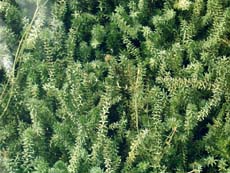Cutting Hydrilla Verticillata with the Lake Mower™
Cutting Down on Hydrilla

Hydrilla (Hydrilla Verticillata) is considered the most problematic aquatic plant in the United States and can severely impact water delivery systems. Using the Jenson Lake Mower™ to remove hydrilla is appropriate when the infestation is at a level that makes it difficult to completely eliminate. The aim then becomes providing fishing and boating areas or cutting with ecological goals in mind. At lower infestation levels, other management strategies such as herbicides or careful manual removal carry less danger of aiding the spreading of the very aggressive plant. It’s always advisable to remove the cuttings. For bigger bodies of water, a fleet of Lake Mowers™, even mounted two to a boat, offers an affordable solution that could start out small and grow as the budget allows. In contrast to large mechanical harvesters, laborers can easily be trained in cutting hydrilla with the Lake Mowers™ safely, and maintenance cost is extremely low.
Growth Habit
Hydrilla forms dense mats of vegetation that interfere with recreation and destroy native plants that provide habitat for fish and wildlife. Unlike other problem aquatic plants, like Brazilian elodea, that reproduce only by fragmentation, hydrilla spreads by seeds, tubers, plant fragments, and turions (overwintering buds). One square meter of hydrilla can produce 5,000 tubers. Once hydrilla becomes established, it is readily spread by waterfowl and boating activities.
Hydrilla has several advantages over other plants. It will grow with less light and is more efficient at taking up nutrients than other plants. It also has extremely effective methods of propagation. Besides making seeds (seedlings are actually rarely seen in nature), it can sprout new plants from root fragments or stem fragments containing as few as two whorls of leaves. Recreational users can easily spread these small fragments from waterbody to waterbody.
However, hydrilla’s real secret to success is its ability to produce structures called turions and tubers. (Presence of these structures is also a characteristic which distinguishes this plant from similar looking plants.) Turions are compact “buds” produced along the leafy stems. They break free of the parent plant and drift or settle to the bottom to start new plants. They are 1/4 inch long, dark green, and appear spiny. Tubers are underground and form at the end of roots. They are small, potato-like, and are usually white or yellowish. Hydrilla produces an abundance of tubers and turions in the fall. Tubers may remain dormant for several years in the sediment. The hydrilla variety found in Washington will also make tubers in the spring and will produce nondormant turions throughout the growing season. Tubers and turions can withstand ice cover, drying, herbicides, and ingestion and regurgitation by waterfowl.
There are two varieties of hydrilla in the United States. Many of the plants in the southern United States are all one sex (female). The plants in Washington are monoecious (having both male and female flowers on the same plant). In New Zealand, where hydrilla has also been introduced, the hydrilla plants are all male. Generally the northern-most populations of hydrilla in the United States are monoecious. Monoecious hydrilla looks and grows somewhat differently than the southern female populations. It tends to have a delicate appearance and sprawl along the lake bottom. The tubers from these monoecious plants are smaller than tubers produced by their southern female relatives.
